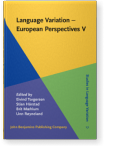Word order variation and foregrounding of complement clauses
Exploring the meaning of sentence adverbials as signals of word order
Through mixed models analyses of complement clauses in a corpus of spoken Danish we examine the role of sentence adverbials in relation to a word order distinction in Scandinavian signalled by the relative position of sentence adverbials and finite verb (V>Adv vs. Adv>V). The type of sentence adverbial was the third-most important factor in explaining the word order variation: Sentence adverbials categorized as ‘dialogic’ are significantly associated with V>Adv word order. We argue that the results are readily interpretable in the light of the semantico-pragmatic hypothesis that V>Adv signals foregrounded information, and exploit the random intercepts assigned to the individual adverbials for further exploring the functions of sentence adverbials that behave unexpectedly based on the predictions of the model.
